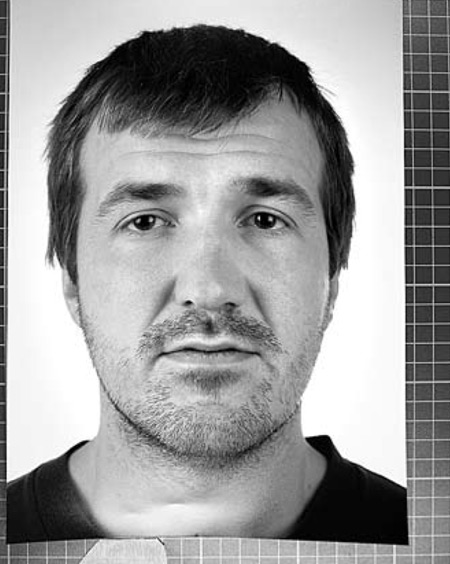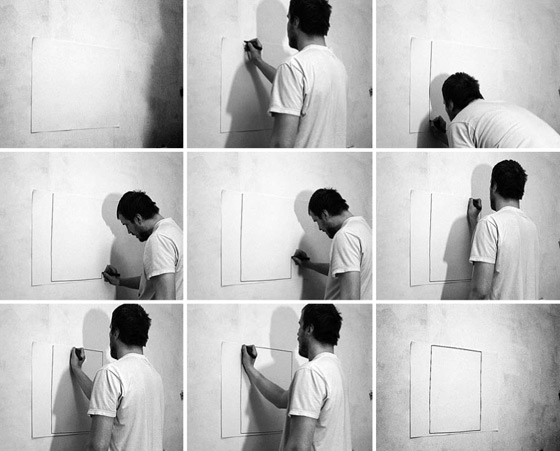|
|
| Klāvs Upaciers Dita Birkenšteina, Art Academy of Latvia | |
| Klāvs Upaciers (born 1979) is currently studying towards a Mas ter’s degree in the Department of Visual Communication (DVC) at the Art Academy of Latvia. His works have been displayed in several group exhibitions, among them the student exhibition Rough Art – for Rough Men (2010), which was organized for the inmates of the Brasa Prison. Upaciers has also had a chance to take part in our own international contemporary art festival Survival Kit 3 (in cooperation with Brigita ZelčaAispure) and Survival Kit 4, and last autumn held a solo show Viena zīmējuma izstāde (‘One Picture Exhibition’) at the Office Gallery in the Cen tre for Contemporary Art. | |
 Klāvs Upaciers. 2012 Photo from the private archive of Klāvs Upaciers | |
| Perhaps somewhat unusually for graduates of the DVC, Klāvs Upaciers has chosen to give preference to the traditional skill of an artist: drawing, leaving digital techniques in the back ground. The artist made this choice in the belief that drawing still has many undiscovered opportunities to offer. Another im portant aspect is the process of drawing itself, which to him is an excellent way to liberate oneself from thoughts and to es tablish inner lucidity. Drawing allows the passing on of informa tion which is impossible to share in verbal or written format. As this information materializes, drawings emerge which could be defined as relative thought maps. In the context of Upaciers’ drawings it is impossible to speak about specific subject matter or images – the artist distances himself from a pictorial rendi tion so that a drawing is not an illustration and the message is not revealed too directly. This approach lends a pleasant fresh ness to his works. Upaciers did not lose his predilection for drawing also when he participated in the Survival Kit 4 (2012) with a kinetic installa tion Nepārtraukta izvēle (‘Uninterrupted Choice’ (a fan, a plas tic bag, charcoal and paper)). The installation is a mechanical drawing machine run by a ventilator, and its monotonous and rhythmical movements create drawings on paper. No matter how mechanical it may be, this machine in its essence carries quite a human message, that is, at the basis of the functioning of the human body and mind there is a “motor” which stimu lates incessant movement and choice of direction. The result ing subjective experience is being continuously recorded, thus creating the particular individual, just like the moving machine creates the drawing on the paper. “The more I look around in all directions, the more I notice. And the things that are there to be seen are continually increasing in number. Choice is, in my understanding, the privilege of beings that have self awareness. (...) And if initially I thought that the “drawing ma chine” was just a pretty toy, then now I am beginning to think that I have created a selfportrait. A sort of an idealized self portrait, because it doesn’t always turn out so well. Probably at times I make the wrong choices,”(1) – thus the author comments his work. | |
 Klāvs Upaciers. Square. Video stills. 22‘. 2009 Publicity photos Courtesy of the artist | |
| Space plays a significant role in the works of Klāvs Upa ciers – it is simultaneously a workshop, part of the drawing and an exhibition hall. Beginning with his bachelor’s degree work, the artist has been keen to go beyond the limitations of paper sheets and works at a larger scale using the walls. In his bach elor’s work (scratch) (2011) Klāvs “populated” the walls of the apartment at Merķeļa iela 19A, where he was living at the time. Each room in the apartment received a unique drawing, and even though at the first glance it may seem that at least some of the drawings were created as a result of chaotic, momentary impulses, such a supposition is false each drawing is made by following previously set out rules. For instance, there is a draw ing that consists of a continuous line done in blacklead, another drawing is a jumble of innumerable lines 10 centimetres, and yet another drawing is made up of patches of figures with strings of writing and numbers. In his ‘One Picture Exhibition’ (2012) Upaciers continued what he had started in his bachelor’s work. The title of the show speaks for itself – the exhibition consisted of one drawing on the walls of the Office Gallery. There were selfimposed rules and guidelines also in the creation of this work as well: in this case, one part of the drawing was done blind, drawing with the eyes closed and trusting his inner vision, but the second part of the drawing was done with his eyes open, thus in full control of the drawing process aided by sight. One of the critical aspects worth mentioning is the architectural peculiarities of the space. The attic space of the Office Gallery is in itself dynamic and offers much more than the traditional four walls. Possibly the multi faceted room is not the most forgiving space for exhibitions, however, in the case of Klāvs Upaciers it was a total success. It is hard to imagine a space that would be more appropriate for this exhibition – due to the unusual shape of the room his already engaging work gained additional dynamics – predicting the movement of the viewer in the room and presenting count less viewing points and possibilities of perception. The drawing was created using a comprehensive arsenal of graphic “weapons”, both the more usual media such as graph ite pencils, chalk and luminescent markers, as well as the less standard materials such as thread, cables and coloured insu lating tape which also served as lines. Similarly as in his other works, Upaciers consciously avoided an illustrative approach, and the drawing denied the opportunity to identify any clear images. The viewer was given an informational scheme, the key to which was held only by the artist himself, but the viewer was encouraged to use the scheme as a framework for creating their own images, and quite simply to surrender to the movement of the lines in order to discover ever newer and unique ver sions hidden in the legend of the map: the possibilities for in terpretation were endless. The toolbox left on the floor worked as a direct invitation from the artist and it evidently elicited a response on the part of the viewers. Those who had a chance to visit the exhibition several times were able to evaluate the changes to the drawing (a few days before the closing of the exhibition Upaciers’ drawing had been joined by textual additions which were a bit foreign to the context, abstract strings of letters, as well as various companies of fantastic creatures, beasts and squiggles). The vast tonally dark spaces on one side of the room and the muddle of “blind” lines dancing across the room in a wild rhythm, interspersed with the vividness of col our markers and scotch tape, bestowed a feeling of vitality to the room. The room which had acquired a much more buoyant atmosphere than usual gave free rein to fantasy, so that the viewer followed the countless paths of lines if not with their fingers, then at least with their eyes. And if art is able to get moving a viewer’s fantasy, it could be said that the artist’s ef forts have paid off. On the young artists’ scene Klāvs Upaciers has shown to be an interesting figure. His chosen method of working points in the direction of conceptual art and brings about involuntary comparison with the series of wall drawings by Sol LeWitt start ed in the 1970s (the most recent drawings were done in the last decade). The basis for such a comparison is in the direct simi larities of form (drawings are done on the walls, the materials used), but the approach to the carrying out of the work points to a significant difference. In the case of Sol LeWitt, the artist supplied the concept but the execution of the work was left in the hands of other draughtsmen. LeWitt justified his choice say ing that “each person draws a line differently and each person understands words differently” 2, thus expressing a view that the process of implementation of an artwork is marginal and un important. Klāvs Upaciers uses an oppositionary approach, and highlights the materialization of an idea as a process in which the artist’s collaboration is irreplaceable. Translation into English: Vita Limanoviča 1 Survival Kit 4 newspaper. Editor Zane Zajančkauska. Riga: Contemporary Art Centre, 2012. 2 www.guardian.co.uk/culture/2006/dec/07/2 (viewed 07.12.2012.). | |
| go back | |







